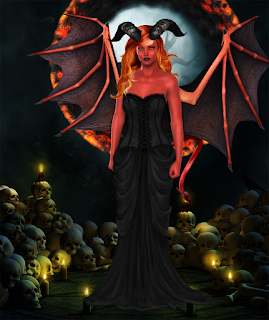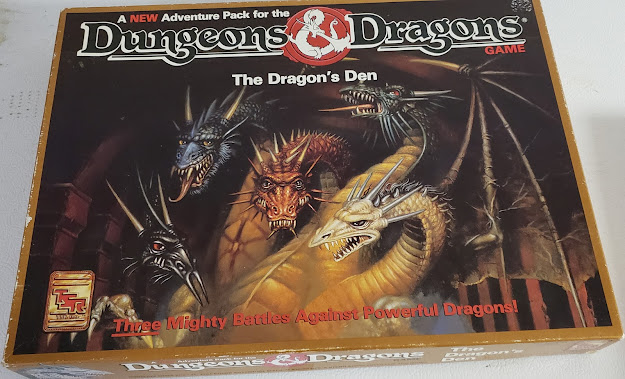 |
| Raven by Luis Royo |
One book they always prominently displayed was the American versions of Raven Swordsmistress of Chaos.
I never grabbed the book but as an 18-year-old guy, I always was attracted to the covers. I even had a character named Raven, who like the cover, was blonde and had a pet raven. I was vaguely aware there were more books in the series, but never knew how many.
Over the last couple of years, I have been on a quest to find and read all the Raven books by "Richard Kirk" who was, in reality, the pen name of authors Angus Wells and Robert Holdstock. Both wrote Book 1 and then they alternated with Wells on Books 3 and 5 and Holdstock on Books 2 and 4.
The story Raven begins with that of a runaway slave girl named Su'ann. She is rescued by a mysterious warlock-like character named Spellbinder, who recognizes that she is "the pivot on which the world turns" partially because she is also protected by giant Raven and he senses something in her. Spellbinder and Su'ann, now calling herself "Raven," hook up with a band of outlaws and pirates. They go from adventure to adventure but all the time Raven is training with swords, spears, and what would become her "trademark" a set of throwing stars. It was the 70s, man. Raven though is not training out of boredom, nor even for the higher purpose fate seems to have, but is very vague about, for her. She wants to kill her former slave owner, the Swordsmaster Karl Ir Donwayne.
Well, I succeeded in my quest and I found them all and read them.
While they are not...good...they are fun little romp in late 70s Swords and Sorcery (and Sex, but not as much as the Corgi covers hint at). Sometimes described as a mildly ribald Red Sonja or a less ribald Ghita Of Alizar. The books however perfect for game fodder.
Others have reviewed the books and I went back and forth on whether I should do the same. So instead I am just going to link out to some of the better reviews and retrospectives for your own reading.
I figured there are five books in the Raven saga and there are five rule sets in the BECMI series.
Seems like a good fit. Plus it let's me try out each set of rules with a character.
I also did this with my very first character, the Lawful Cleric Johan Werper. While I find him interesting I figure you all would like to see Raven more. Also I wanted to get a good feel for how the fighter works in all sets AND the advanced fighter paths from the Companion rules. So let's get to it!
Raven Swordsmistress of Chaos
 |
| Raven from Heroforge |
While Raven is the cover girl and the eponymous main character, Spellbinder narrates and tells the events many years after the fact. Even the scenes where he was not present.
The story is one that is simple, but close to many FRP gamers. Raven wants to kill Karl Ir Donwayne. How is it going to do that? Well, they need to Skull of Quez to appease this ruler to get to Donwayne. But they have to find the mysterious island first and then kill the beastmen. And there are shadowy loners, men with mysterious pasts. Raven jumps in and out of bed with Spellbinder, Gondar the Pirate captain, and even Krya M'ystral, the Queen and sister of the ruler they were trying to go see. This is all in the first book. There is a nice gory battle with Karl Ir Donwayne too, but he comes back in future books to bother Raven some more.
We never get a satisfactory end to Raven's story. Book 5 just ends. Though all the books are told from Spellbinder's point of view they could be out of order. We do know that Raven met some sort of end between Book 5 and Spellbinder's remembering which seems to take place many years later. Maybe she became that agent of Chaos after all.
For this I am going to stat up Raven for each rule set in the BECMI rules, trying to feature what I feel are the best parts. I am also going to try to feature what I can from what she was doing in the books.
 |
| Raven, ePic Character Generator |
Sheets are from The Mad Irishman.
Basic
Here is the Basic version of Raven. The hardest this is always to guess at what any one character's numbers are going to be. I figure she had good strength and constitution as well as high dexterity since she favors the throwing stars. Her charisma is very high, not because of her looks, but because she inspires a lot of loyalty from the cutthroats she usually hangs out with.
She is a fighter. No doubt. I also gave her alignment as Chaotic. She is a force of chaos, but she is also a killer. For this example, I thought putting her at level 3, or "Swordmistress" (no middle "s" like the books) was appropriate even for her first book.
You can see her full Basic sheet here (click for larger):
Expert
Fighters don't get a lot in the Expert set. So for her 2nd book I just advanced her to 9th level "Lady" and gave her some magical chain mail.
You can see her full Expert sheet here (click for larger):
Companion
Ah now here are some changes!
In the Companion rules, we have more going on. First I wanted to have her become an Avenger or the Chaotic traveling Fighter. She obviously has no lands to call her own and she is still going about killing things. But the Avenger gives her some Clerical ability.
Magic is rare and dangerous in Raven's world. But everyone seems to have some sort of supernatural sort of talent. So for Raven, I choose spells that fit in with role as the "pivot on which the world turns" and other things like her raven companion. So things like "detect magic" and "cause fear" made sense. She also got the 3rd level spell "striking" since that covers a lot of what could be a natural talent.
She also gets 2 attacks per round now at 18th level.
You can see her full Companion sheet here (click for larger):
Master
Master level Raven is really Ultimate Raven. This is the Raven that goes toe to toe with gods and spirits and comes out unscathed.
She gets three attacks per round now and I implemented the Weapon Mastery Rules to give her mastery over the sword and her throwing stars.
She gets more cleric spells, this time to the 10th level of ability. Some spells are easily explained by her connection to her bird, fate, and chaos. Others can be explained by natural ability. "Commune" for example is with her bird and the forces of Chaos only. "Speak with Animals" can be roughly explained by her time with the animal men. Others could be when she was dealing with weird supernatural forces.
She also gets 3 attacks per round now.
You can see her full Master sheet here (click for larger):
Immortal
This sheet is largely incomplete. It is also the most different of the other four (printed from my DTRPG copy) and interestingly enough the only book in series that I don't have an American (Royo cover) edition of. I do have the British Corgi version with the Chris Achilléos cover.
I made a lot of guesses as to what sort of Immortal she would be and just cheated and made her an Initiate. I might try this again with one of my own characters that I know better.
You can see her full Immortal sheet here (click for larger):
All in all I rather pleased with these. I am curious to hear from anyone that has also read these books.
As far as BECMI character I am happy with it.
Links
- Stuff I Like, With a Twinge of Embarrassment - "Raven - Swordmistress of Chaos" - by Richard Kirk
- Glorious Trash, Swordsmistress Of Chaos (Raven #1)
- Karavansara, Richard Kirk’s Raven (with all the Chris Achilléos covers)
- Warrior Needs Food, DeviantArt. Raven fan art. (NSFW)
- Raven, Swordmistress of Chaos Pinterest board (Moderately NSFW)



















































